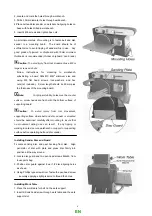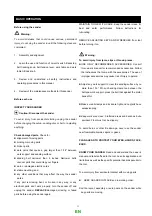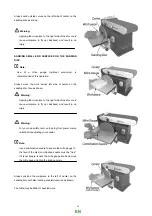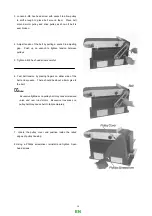
13.
Clear everything except the work piece and related
support devices off the table before turning the sander on.
14.
Plan the way you will hold the work piece from start to
finish.
15.
Avoid awkward operations and hand positions where a
sudden slip could cause fingers or hand to move into a
sanding surface. Keep fingers away from where the belt
goes into the dust trap.
16.
Keep your face and body to one side, out of line with a
possible throwback.
17.
Before starting work, watch the sander while it runs. If it
makes an unfamiliar noise or vibrates a lot, stop
immediately. Press the STOP button on sander. Unplug the
sander. Do not restart until finding and correcting the
problem.
18.
DO NOT FORCE TOOL. Press the work piece against the
sanding material only hard enough to let it sand without bogging
down or binding.
19. Before freeing any jammed material ensure that you
follow the next three steps.
Press the red “STOP” button.
Unplug the sander from the mains power supply.
Wait for all moving parts to stop.
20. WARNING LABELS – It is important that labels bearing
Health & Safety Warnings are not removed or painted
over. New labels are available from Customer Services.
21. MECHANICAL SAFETY – The security of all clamps and
work holding devices should be checked before
switching on.
22. WOOD DUST – The fine particles of dust produced in
sanding operations can be a long term health hazard if
excessive. Some imported hardwoods do give off highly
irritant dust which causes a burning sensation. We
strongly recommend the use of a dust collector and dust
mask/visor. Our Customer Services will be happy to
advise you on the correct unit for your needs.
BEFORE EACH USE Inspect Your Sander
Disconnect the sander
.
To avoid injury from accidental
starting unplug the sander before changing the setup,
sanding disc or belt or adjusting anything.
Check damaged parts.
Check for
alignment of moving parts
binding or moving parts
broken parts
work parts that cause a gap larger than 1/16” between
work support and sanding surface.
sanding belt narrower than 6 inches. Narrower belts
uncover parts that could trap your fingers.
worn or damaged electric cords
stable mounting, and
any other conditions that may affect the way the sander
works.
If any part is missing, bent, or broken in any way, or any
electrical parts don’t work properly, turn the sander off and
unplug the sander.
REPLACE
damaged, missing, or failed
parts before using the sander again.
MAINTAIN TOOLS WITH CARE. Keep the sander clean for
best and safer performance. Follow instructions for
lubricating.
REMOVE ADJUSTING KEYS AND WRENCHES from tool
before turning it on.
To avoid injury from jams, slips or thrown pieces:
USE ONLY RECOMMENDED ACCESSORIES. Consult
this owner’s manual for recommended accessories.
Follow the instructions that come with the accessories.
The use of improper accessories may cause risk of
injury to person.
Adjust any work support to clear the sanding surface by
no more than 1/16”. When checking clearance between
the belt and work support, press the belt that against
the metal beneath it.
Make sure all clamps and locks are tight and no parts
have excessive play..
Keep work area clean. Cluttered areas and benches
invite accident. Floor must not be slippery.
To avoid burns or other fire damage, never use the
sander near flammable liquids, vapors or gases.
3
EN
Summary of Contents for BDS610
Page 2: ......
Page 3: ...Manuel d utilisation MODELE PON250 FR...
Page 19: ...17 13 2 Vue clat e de la machine FR...
Page 22: ...Manual de instrucciones MODELO PON250 ES...
Page 41: ...20 14 DESPIECE ES...
Page 42: ...21 ES...
Page 67: ...Diagram 21 EN...
Page 68: ...Notes...
Page 69: ......
















































